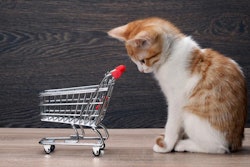
In a new survey, 47 percent of US pet owners reported that they buy their preferred brand of pet food regardless of the availability of coupons or deals. That the percentage isn’t higher probably owes to the fact that the respondents included pet parents from multiple generations, including famously brand-agnostic millennials.
Conducted in May 2016 by Acosta, a sales and marketing agency, the survey showed that 29 percent of respondents do look for pet food coupons or deals through a loyalty program, 25 percent go to retailer websites to search for coupons/deals, 24 percent search brand websites for the same and 20 percent shop online for the best deals.
Unfortunately, the report doesn’t break down those responses by generations – in fact, nowhere does the report even say how many pet owners responded to the survey (total or by generation) or how it was conducted – but my guess is that more Boomers tend to be among the 47 percent always buying their preferred brand. That’s because millennials, now the largest demographic of pet owners in the US, are much less likely to find it important to “get the specific brands I want” when shopping for pet products than are pet parents 35 years old and older, according to Packaged Facts.
On the other hand, millennials are far more likely to have tried a new brand of dog food in the last 30 days. The good news for pet food companies is that 64 percent of these pet owners say they are spending more on pet products (including pet food) than they used to, compared with only 49 percent of owners age 35 or over, Packaged Facts data shows.
Pet food sales top other consumer goods categories
Most of the Acosta survey report covered other pet products and services, along with how pet parents from different generations interact with their pets. News flash: Millennials are more likely to take photos of their pets – 67 percent do so daily or weekly – while Boomers talk their pets to death! Not literally, but 94 percent of Boomers (yes, including me) report talking to their pets daily, compared to only 47 percent of millennials and 64 percent of Gen X pet owners.
Specific to pet food, in terms of “item penetration” (which I interpret to mean percentage of pet owners purchasing them), dog food came in at 35.2 percent for the 52 weeks ending April 2, 2016, with cat food at 30.8 percent and pet treats at 45.7 percent. For comparison, pet accessories hit 44.4 percent and pet bird food, 13 percent. The data came from Nielsen, the report said.
In an interesting comparison, the report showed that US sales of pet food exceed those in many other consumer goods categories, including cheese, candy, milk, beer, wine, bottled water, coffee, frozen pizza and snacks, and baby food. The sales figures were also from Nielsen and seem low, compared to most other sources for pet food data: Acosta said sales of all pet products (including food but not, apparently, pet services or veterinary care) were about US$30 billion, with pet food comprising the majority of that figure. Yet Packaged Facts reported 2015 US pet food sales alone at $30 billion. Still, the comparison among consumer goods categories rings true because all the sales data is from Nielsen.
It’s no surprise that pet food and product sales have far surpassed baby food sales; as of 2014, 38.2 percent of US households had dogs versus 31.7 percent having children, Packaged Facts showed. Compare those data points to the same ones from 10 years before, when 31.1 percent of households had dogs and 35.5 percent had children. I imagine the trend toward dogs over children, which the Acosta report also discussed, is continuing and possibly even accelerating as millennial pet ownership increases yet these younger consumers delay having children or decide to have fewer or none at all.
As for pet food and product spending outpacing that for human treats like candy, beer, wine and frozen pizza, that may also be due to the millennial influence; Packaged Facts data indicated that 52 percent of millennial pet parents say they would rather spend money on pet products than on things for themselves, compared to 39 percent of older pet owners. And unlike Baby Boomers, perhaps they can’t yet afford to have their cake and feed their pets, too.

















